
Using Neem Oil for Indoor Pest Control: A Natural and Effective Solution to Keep Your Home Pest-Free
Are pests invading your home, and you’re looking for a solution that’s both effective and safe? 
Using neem oil for indoor pest control is a game-changer! This eco-friendly, non-toxic solution offers a safe way to eliminate common household pests. What’s even better? Neem oil doesn’t just kill pests—it disrupts their growth, making it a powerful tool to prevent infestations before they start. In this article, we’ll show you how to harness the natural power of neem oil to keep your home pest-free and healthy.
Keep reading to discover how this simple solution can transform your pest control strategy.
Table of Contents
ToggleWhat is Neem Oil? A Quick Overview
Neem oil is a powerful, natural solution that comes from the seeds of the neem tree (Azadirachta indica), which is native to India. 
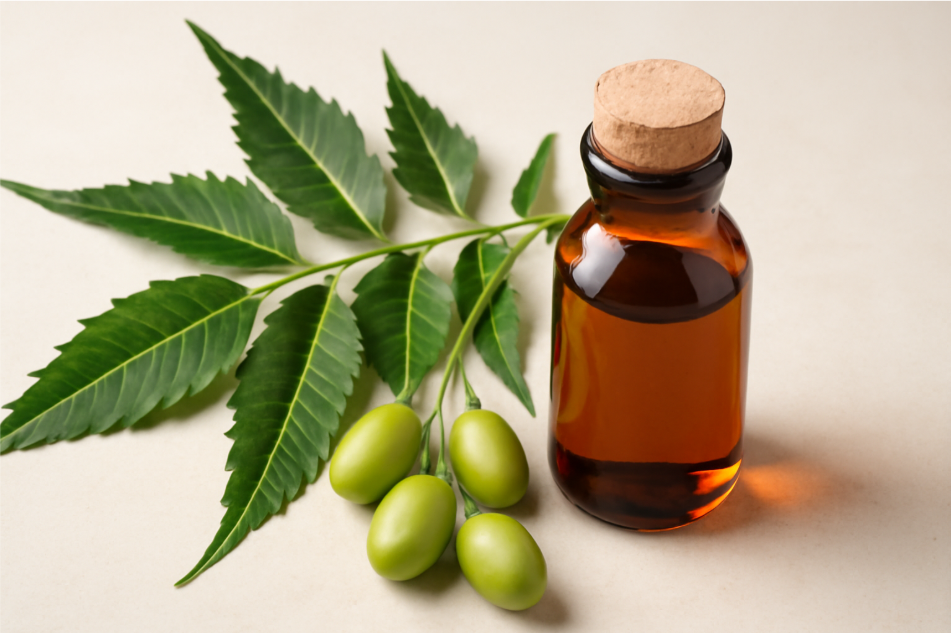
Why Neem Oil Works:
- Active Compounds: The key ingredient in neem oil is Azadirachtin, a compound that disrupts the life cycle of pests by affecting their ability to feed, grow, and reproduce. This means pests don’t just die—they can’t even thrive long enough to cause much damage!
- Natural Pesticide: Neem oil works as a natural insecticide, making it safe for use around your family, pets, and the environment. Unlike chemical pesticides, which can have harmful side effects, neem oil is gentle yet effective when applied correctly.
What Makes Neem Oil Special?
- Non-Toxic: It’s safe for humans and pets, which is a huge advantage over chemical pest control methods. You can use it around kids and animals without worrying about harmful side effects.
- Multi-Purpose: Neem oil is not just for pest control! It also has antifungal and antibacterial properties, making it a great addition to your home care routine for plant health and even personal care.
So, what makes neem oil an effective indoor pest control solution? It’s simple—it targets pests in multiple ways without leaving behind harmful residues. Whether you’re dealing with ants, roaches, or bedbugs, neem oil offers a natural and safe alternative to keep your home pest-free.
Common Indoor Pests Neem Oil Targets
Neem oil is a versatile and effective solution for controlling a wide range of indoor pests. Let’s take a look at some of the most common pests that neem oil can help you get rid of and prevent.
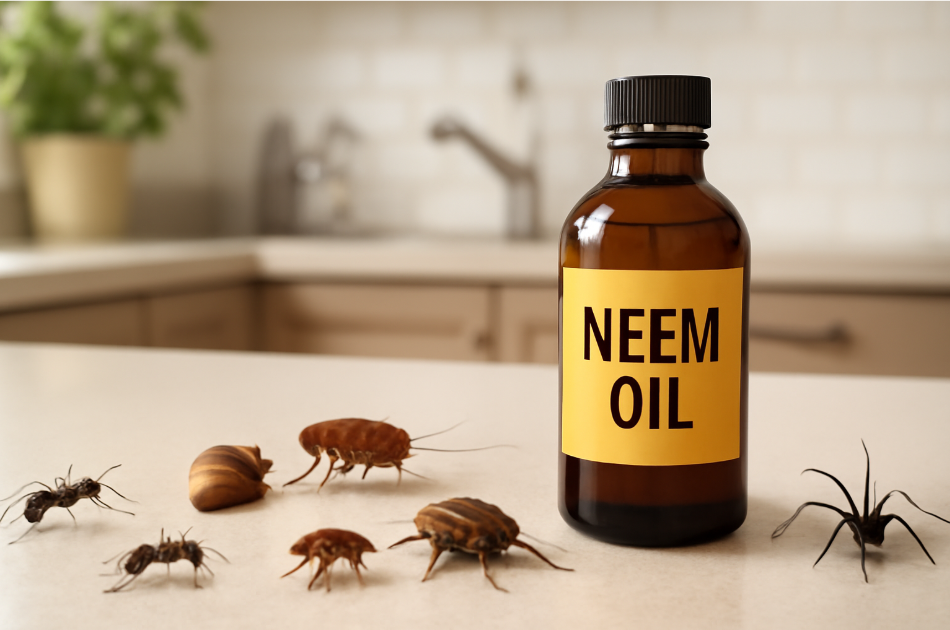
1. Ants
Ants are one of the most persistent pests indoors. Whether they’re marching across your kitchen counter or invading your pantry, neem oil can help disrupt their trails and stop the colony from growing. Simply spray neem oil along the ant trails, and they’ll be driven away without harmful chemicals.
2. Cockroaches
Cockroaches are not only annoying but also carry diseases. Neem oil works wonders on cockroaches by affecting their ability to feed and reproduce. A light spray in cracks and crevices, where cockroaches love to hide, can prevent infestations from taking root.
3. Bedbugs
Bedbugs are notoriously difficult to eliminate, but neem oil can help. When sprayed on affected areas like mattresses and bedding, neem oil interferes with the bedbugs’ ability to reproduce and feed. Over time, this reduces their numbers significantly.
4. Fleas
Fleas, especially in homes with pets, can become a major problem. Neem oil can be used on pets and in the home to kill fleas at all stages of life—from eggs to adults. Make sure to dilute neem oil and use it carefully on your pets, ensuring it’s safe for them.
5. Spiders
Neem oil is also effective at keeping spiders at bay. While spiders are beneficial for controlling other pests, having too many indoors can be a nuisance. Spray neem oil around windowsills, doorways, and corners to repel spiders naturally.
6. Moths
If you’ve ever had your clothes or pantry items ruined by moths, you know how frustrating they can be. Neem oil can be used to treat infestations in your wardrobe and pantry. Spray it on affected fabrics and surfaces to prevent moth larvae from damaging your belongings.
7. Aphids (on houseplants)
Aphids love to infest indoor plants, sucking the life out of your favorite greenery. Neem oil is an excellent way to keep these pests at bay without harming your plants. Simply spray neem oil on the leaves and stems to protect your plants.
How Neem Oil Works as a Pest Control Solution
Neem oil is not just another insecticide—it’s a natural solution that works in multiple ways to control and eliminate pests in your home. Understanding how neem oil works can help you use it more effectively and make the most out of its powerful properties.
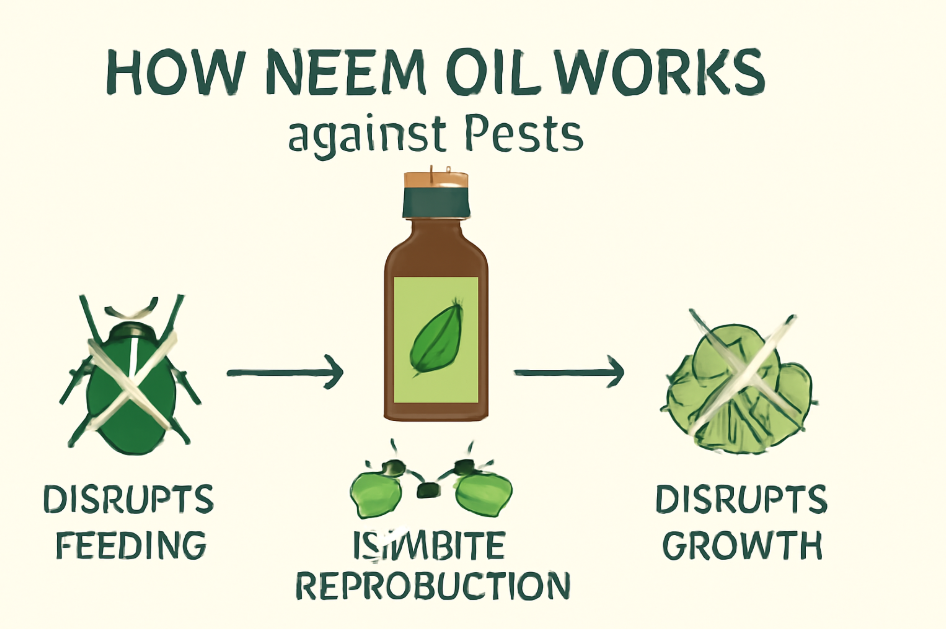
1. Disrupts Pests’ Feeding and Growth
The primary ingredient in neem oil, Azadirachtin, affects pests in a way that no other common pesticide does. When pests come into contact with neem oil, it interferes with their ability to feed. This disrupts their nutrition and leads to starvation, weakening them over time.
- How it works: Neem oil blocks the pests’ feeding receptors, making it impossible for them to continue eating. As a result, they stop feeding and eventually die off.
2. Inhibits Reproduction
One of neem oil’s most powerful features is its ability to stop pests from reproducing. When pests ingest or come into contact with neem oil, it alters their hormone systems, preventing them from mating or laying eggs. This significantly reduces the number of new pests in your home.
- How it works: Neem oil interferes with the hormones responsible for reproduction in pests, preventing them from reaching maturity or reproducing.
3. Acts as a Repellent
Neem oil doesn’t just kill pests—it also repels them! When you spray neem oil around your home, it creates a barrier that pests find unpleasant, making your space less inviting. It’s an excellent tool to keep pests from returning, especially when used as a preventive measure.
- How it works: The strong scent of neem oil confuses pests and makes your home smell like an area they want to avoid.
4. Safe for the Environment
Unlike chemical pesticides, neem oil is non-toxic to humans, pets, and beneficial insects like bees and ladybugs. This makes it a safe and eco-friendly choice for households looking to control pests without harming the environment.
- How it works: Neem oil naturally breaks down in the environment, leaving no toxic residue behind, ensuring your home remains safe and healthy.
5. Works on All Stages of Pest Life
Neem oil doesn’t just target adult pests—it’s effective against pests in all life stages, from eggs to larvae to fully grown insects. This makes it a comprehensive solution for preventing and eliminating infestations.
- How it works: Neem oil disrupts pest growth at every stage, preventing larvae from maturing into adults and ensuring any existing eggs are not able to hatch.
How to Use Neem Oil for Indoor Pest Control
Using neem oil for pest control is simple, effective, and safe when done correctly. This section will guide you step-by-step on how to prepare and apply neem oil, so you can quickly tackle any indoor pest problems.
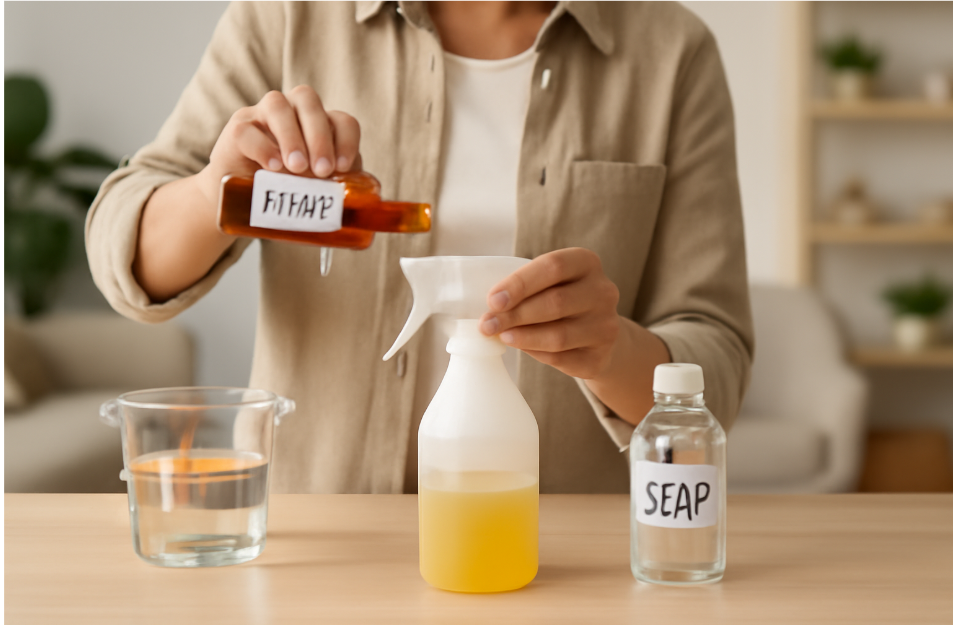
1. Prepare the Neem Oil Solution
To get started, you’ll need to dilute the neem oil. It’s important to follow the right ratio to ensure it’s both effective and safe for your home.
What you’ll need:
- Neem oil (pure, cold-pressed)
- Water (distilled or tap water)
- Mild liquid soap or dish detergent (helps emulsify the oil)
- A spray bottle or garden sprayer
How to mix:
- For general pest control, mix 2 tablespoons of neem oil with 1 quart (4 cups) of water.
- Add 1 teaspoon of mild liquid soap to help the oil blend properly with the water.
- Shake the mixture well to combine.
Pro Tip: If you have a more severe pest problem, you can increase the concentration to 3 tablespoons of neem oil per quart of water.
2. Application: Where and How to Spray
Once your neem oil solution is ready, it’s time to apply it around your home.
General tips:
- Spray directly on pests: For visible pests like ants or cockroaches, spray the solution directly on them to stop them in their tracks.
- Target affected areas: Spray areas where pests are hiding, such as cracks, crevices, baseboards, windowsills, and around doors.
- Use in hard-to-reach places: Cockroaches and bedbugs love hiding in tight spaces, so don’t forget to spray under furniture, inside cabinets, and behind appliances.
- Spray directly on pests: For visible pests like ants or cockroaches, spray the solution directly on them to stop them in their tracks.
For plants:
- Neem oil is also great for protecting your houseplants from aphids, mites, and other pests. Spray it lightly on the leaves and stems, but avoid heavy application that could block sunlight from reaching the plant.
Tip: Always test a small area of your plant first to make sure neem oil doesn’t cause any damage.
3. When to Apply
For the best results, apply neem oil when pests are most active, typically early morning or late evening. Avoid spraying during the hottest part of the day, as the sun may break down the oil’s effectiveness.
Frequency of application:
- For preventive pest control, spray every 1-2 weeks.
- If you’re dealing with an infestation, apply the solution every 3-4 days until the problem is under control.
4. Clean Up and Storage
After spraying, make sure to clean any surfaces or objects that may have come into contact with the neem oil solution.
- Clean-up: Wipe down any kitchen counters or dining areas if they were sprayed.
- Storage: Store any leftover neem oil solution in a cool, dry place away from direct sunlight. Be sure to label the bottle for future use.
Important: Neem oil can go rancid over time, so try to use it within 3-4 weeks of mixing.
Section 5: Benefits of Using Neem Oil for Pest Control
Neem oil is a powerful, natural solution that offers numerous benefits for indoor pest control. Let’s take a look at why it’s quickly becoming the go-to choice for eco-conscious homeowners.
1. Safe for Humans and Pets
One of the biggest advantages of using neem oil for pest control is that it’s non-toxic to humans and pets when used as directed. Unlike traditional pesticides that can harm your health and your furry friends, neem oil is completely safe to use around your family and pets.
- Why it matters: You don’t have to worry about harmful chemical residues on your furniture, in your air, or on surfaces your children or pets touch.
2. Eco-Friendly and Sustainable
Neem oil is a biodegradable and environmentally friendly option. It breaks down naturally in the environment, leaving no toxic residue. Using neem oil for pest control helps protect beneficial insects like bees and ladybugs, making it a great choice for eco-conscious homeowners looking to reduce their environmental impact.
- Why it matters: You can keep pests away without harming the planet or non-target organisms.
3. Effective for a Wide Range of Pests
Neem oil is incredibly versatile. It works effectively against many common indoor pests, including ants, cockroaches, bedbugs, fleas, spiders, and more. Unlike some pest control methods that only target specific pests, neem oil can handle a broad range of unwanted guests.
- Why it matters: One natural solution can tackle multiple pest problems, saving you time, money, and effort.
4. Prevents Future Infestations
Not only does neem oil kill pests, but it also acts as a repellent, helping to prevent future infestations. When applied regularly, neem oil creates a barrier that pests find unpleasant, keeping them away from your home.
- Why it matters: You don’t have to wait for pests to appear; neem oil works proactively to keep your home pest-free.
5. Non-Residue and No Harmful Smells
Neem oil doesn’t leave behind any sticky residue, and its natural smell dissipates quickly after application. This makes it an ideal choice for indoor use, where you want a clean and pleasant environment.
- Why it matters: You won’t be left with greasy surfaces or an overpowering chemical scent.
6. Affordable and Easy to Use
Compared to many commercial pesticides, neem oil is cost-effective and easy to apply. You can purchase neem oil at an affordable price and use it in a simple spray bottle. There’s no need for special equipment or complicated procedures.
- Why it matters: Pest control doesn’t have to be expensive or difficult. Neem oil provides an accessible solution for every homeowner.
Tips for Maximizing Neem Oil’s Effectiveness
To get the most out of your neem oil and ensure long-lasting pest control, it’s important to use it correctly and consistently. Here are some expert tips to help you maximize its effectiveness in keeping your home pest-free.

1. Apply Neem Oil Regularly
For best results, consistency is key! Apply neem oil every 1-2 weeks as a preventive measure, even if you don’t see any pests. Regular use creates a barrier that repels new pests from entering your home.
- Why it works: Pests are less likely to invade a home that’s consistently treated with neem oil, as the oil disrupts their ability to thrive.
2. Target Pest Hotspots
Focus your application on areas where pests are most likely to be. These include:
- Cracks and crevices where pests hide
- Entry points like windows and doors
- Underneath furniture or appliances, where pests often nest
- Around plants, if you’re dealing with aphids or other plant pests
- Why it works: By targeting high-traffic pest areas, you’re directly addressing the root of the problem, ensuring neem oil works efficiently.
3. Don’t Over-Apply
While neem oil is natural, more isn’t always better. Applying too much oil can result in oily residues on surfaces, especially on plants. It can also cause a slight build-up over time.
- Why it works: A light, even misting is all that’s needed to disrupt pests’ feeding and breeding cycles. Over-applying may not enhance its effectiveness but could lead to waste.
4. Combine with Other Natural Methods
Neem oil is highly effective on its own, but you can enhance its impact by combining it with other natural pest control methods:
- Maintain cleanliness: Regularly vacuum, wipe surfaces, and keep food stored tightly to avoid attracting pests.
- Seal entry points: Ensure that doors, windows, and cracks are sealed to prevent pests from coming in.
- Use diatomaceous earth: This natural powder works alongside neem oil to create a more comprehensive pest control strategy.
- Why it works: Using neem oil alongside other methods creates a more holistic approach, tackling pests from multiple angles.
5. Time Your Application Carefully
Apply neem oil during the cooler parts of the day, such as early morning or late evening. Avoid spraying during peak heat, as the oil may break down faster when exposed to direct sunlight, reducing its effectiveness.
- Why it works: Neem oil is best absorbed when it’s not subjected to extreme temperatures, ensuring it lasts longer and works effectively.
6. Test on a Small Area First (for Plants)
Before spraying neem oil directly on your plants, always do a spot test on a small area first. While neem oil is safe for most plants, some sensitive species may not respond well.
- Why it works: This ensures that your plants won’t be damaged, allowing you to safely protect them from pests like aphids and spider mites.
Potential Risks and Side Effects of Neem Oil
While neem oil is generally safe and effective for pest control, it’s important to be aware of its potential risks and side effects. Understanding these can help you use neem oil safely and get the best results. Here’s what you need to know.
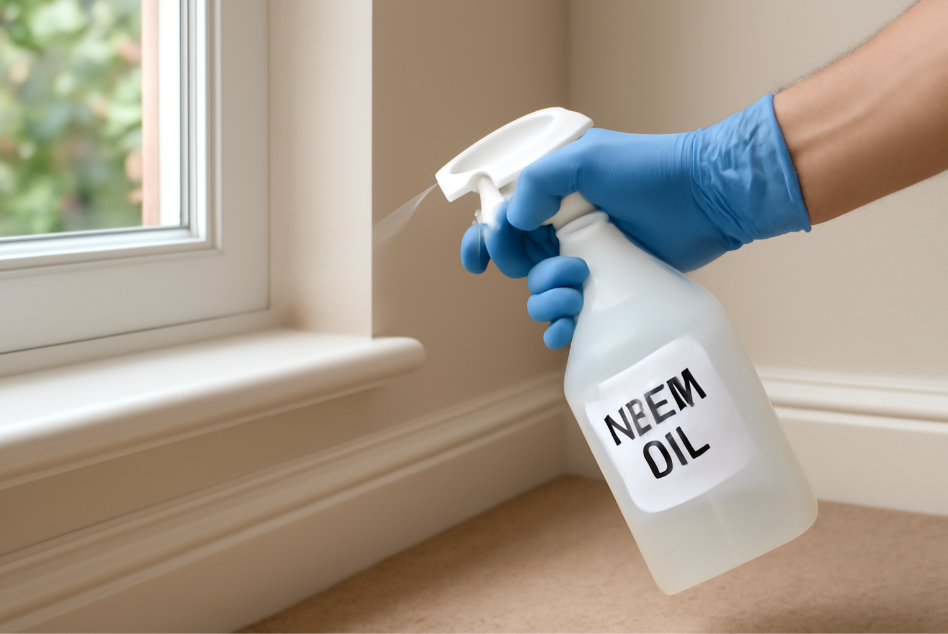
1. Skin Irritation
In rare cases, neem oil can cause mild skin irritation, especially if you have sensitive skin. If you’re applying neem oil directly to surfaces or using it for pets, it’s a good idea to wear gloves during application.
- What to do: If you experience any irritation after coming into contact with neem oil, wash the affected area with soap and water. If irritation persists, seek medical advice.
2. Sensitivity in Some Plants
While neem oil is safe for most plants, certain sensitive species, such as delicate flowers or young seedlings, may be more prone to damage. Always do a patch test on a small area of the plant before applying neem oil to the entire surface.
- What to do: Spray a small amount of diluted neem oil on one leaf and wait 24 hours to check for any adverse reactions like wilting or discoloration.
3. Harmful to Aquatic Life
Neem oil can be harmful to aquatic life, so it’s important not to use it near ponds, fish tanks, or any area where it could reach water. Even small amounts of neem oil can be toxic to fish and other aquatic creatures.
- What to do: Keep neem oil away from water sources. If you spill it accidentally, clean it up promptly to prevent contamination.
4. Overuse May Harm Plants
While neem oil is effective at keeping pests away, overuse can cause some plants to show signs of stress, such as yellowing leaves or stunted growth. This is typically due to too much oil coating the plant’s surface.
- What to do: Use neem oil in moderation and follow the recommended dilution rates to avoid overapplication. Apply it sparingly to prevent plant damage.
5. Strong Odor
Neem oil has a distinct smell that many find unpleasant. While it dissipates over time, it can be a bit strong during and immediately after application.
- What to do: If the smell bothers you, ensure that the treated areas are well-ventilated. The odor will naturally fade after a few hours.
6. Accidental Ingestion (Pets and Children)
Although neem oil is non-toxic when used properly, accidental ingestion can cause mild symptoms like stomach upset in pets or children. Always keep neem oil and its diluted solutions out of reach of young children and pets.
- What to do: In case of accidental ingestion, contact a healthcare provider or veterinarian immediately for guidance.
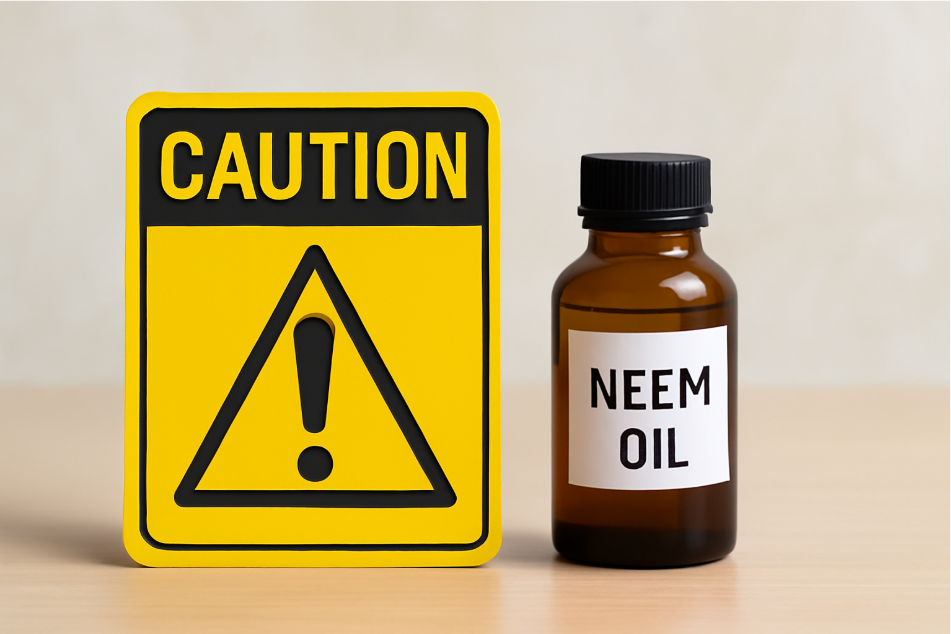
Neem oil offers a safe, eco-friendly, and highly effective way to control indoor pests without relying on harmful chemicals. Whether you’re dealing with ants, cockroaches, bedbugs, or pests that target your plants, neem oil provides a versatile solution that is easy to use and safe for your family and pets.
By understanding how neem oil works, how to apply it effectively, and the best practices to maximize its benefits, you can keep your home pest-free in a natural and sustainable way. Its ability to disrupt pests’ feeding, reproduction, and growth makes it a powerful tool in your pest control arsenal.
Remember to follow the guidelines for safe use and application, and don’t hesitate to integrate neem oil with other natural pest control methods for even better results. With regular use, neem oil will help you maintain a cleaner, healthier, and more comfortable living environment without compromising your health or the planet.
Say goodbye to harsh chemicals and hello to a safer, greener approach to pest control. With neem oil, you can confidently protect your home, your loved ones, and the environment.
FAQs: Using Neem Oil for Indoor Pest Control
1. Is neem oil safe for pets and children?
Yes, neem oil is generally safe for pets and children when used correctly. It is non-toxic to humans and animals, but it’s a good idea to keep pets away from freshly sprayed areas until the solution dries. Always use neem oil as directed to avoid any accidental ingestion.
2. How often should I apply neem oil for pest control?
For regular pest control, apply neem oil every 1-2 weeks. If you’re dealing with a larger infestation, apply it every 3-4 days until the problem is under control. Regular use helps prevent pests from returning.
3. Can neem oil be used on indoor plants?
Yes, neem oil is safe for most indoor plants and is an excellent natural solution for pests like aphids and spider mites. However, always test it on a small area of the plant first to ensure it doesn’t cause any damage.
4. What pests can neem oil control indoors?
Neem oil is effective against a wide range of indoor pests, including ants, cockroaches, bedbugs, fleas, spiders, moths, and plant pests like aphids and mealybugs. It works by disrupting their feeding, growth, and reproductive cycles.
5. Can neem oil be used as a preventive measure for pests?
Yes, neem oil is an excellent preventive pest control solution. Regular application can keep pests at bay by creating a barrier that repels them, preventing infestations before they start.
6. Does neem oil leave a residue on surfaces?
Neem oil may leave a slight oily residue on surfaces, but it is non-toxic and safe. If you’re concerned, you can wipe down any treated surfaces after the oil has dried to remove any excess residue.
7. How do I mix neem oil for pest control?
To mix neem oil, combine 2 tablespoons of neem oil with 1 quart (4 cups) of water. Add 1 teaspoon of mild liquid soap to help emulsify the mixture. Shake the solution well and apply it directly to affected areas.
8. Is neem oil harmful to the environment?
No, neem oil is environmentally friendly. It breaks down naturally and does not harm beneficial insects like bees when used as directed. It’s a safe, eco-conscious alternative to chemical pesticides. 🌍














